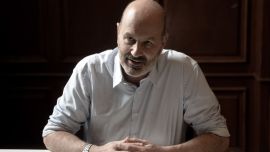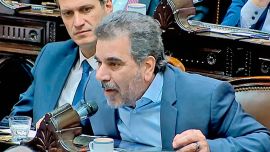If the United States has New York, Italy has Lombardy and China has Wuhan, Argentina has its own readymade epicentre for the coronavirus pandemic and it is called Greater Buenos Aires – an accident still waiting to happen at time of writing.
Prominent among the many adverse conditions marking out this urban sprawl as an easy target for Covid-19 is the overcrowding in so many low-income neighbourhood dwellings, an acute housing shortage determining the choice for today’s “Ministry Positions” column. The official name of the brand-new portfolio facing this enormous challenge at such an early point in its existence is the Territorial Development and Habitat Ministry but for the sake of good plain English it will hereinafter be called the Housing Ministry in the rest of this column.
A dire housing situation which all too often prevents the “social distance” from being observed even within the home, even when heeding the quarantine will be the focus of this column. But let us first introduce the minister – Rosario architect María Eugenia Bielsa, 62. With the possible exception of Cabinet Chief Santiago Cafiero , she has a more interesting family background than any minister, especially her two remarkable brothers Rafael and Marcelo. The first foreign minister of Kirchnerismo (2003-2005) and now Ambassador to Chile (yet to cross the Andes thanks to coronavirus), Rafael Bielsa has recently made news splashes by co-authoring the book Lawfare, expounding the thesis that Kirchnerite corruption trials are an invention of political persecution – this might seem to mark him out as a mere sycophant of current Vice-President Cristina Fernández de Kirchner except that he had the curious tendency to mark the most distance from her when she was on top and be most extreme in her defence when she was down (or second fiddle as now). Current Leeds United and former national football coach Marcelo Bielsa is unique among his kind – straying too much from the topic to explain why so his nickname of “El Loco” will just have to speak for itself.
Anyway back to the minister. A decade of work in housing and urban planning in Rosario municipal politics, prior to becoming Peronist lieutenant-governor of Santa Fe Province (2003-2007), gives María Eugenia Bielsa the credentials for her new portfolio. Following a return to Rosario municipal politics (when she defended public housing against projects for gated neighbourhoods), she won more votes than any other candidate in the province when running for the provincial assembly in 2011 – over 300,000. From that point she became something of an Elisa Carrió-style maverick within Santa Fe Peronism, resigning her seat in 2013, when she accused her party of being too soft on the socialist provincial government, and refusing a nomination to be gubernatorial candidate in 2015. She did toss her hat into the 2019 gubernatorial ring, running against the party establishment and eventually losing the Peronist primary to Omar Perotti (who was elected governor last June).
But the main focus should be housing rather than the minister. In broad data Argentina has a housing shortage of almost four million units but of the housing which does exist, around a quarter is substandard – much of that to be found in Argentina’s 4,000- odd shantytowns (villas de emergencia) giving some kind of primitive shelter to around three million people. All in all, over a third of the Argentine population thus has a serious housing problem, very similar to the percentage below the poverty line (officially 35.5 percent).
Beyond the various deficiencies in living conditions in these impoverished neighbourhoods such as the lack of running water, sewage or gas connections (obviously also causing huge health problems), the sheer overcrowding is a gigantic risk factor when facing a coronavirus pandemic. As the INDEC national statistics bureau reported last November, no less than 1.35 million people are huddled into 227,000 dwellings at an average of over three people per room. This is just under five percent of the Argentine population, the poorest of the poor, but some Greater Buenos Aires municipalities report twice that percentage averaging over three a room – when three really is a crowd.
Substandard conditions should never be underestimated – it would be simplistic to take the death tolls from the great epidemics of history as a measure of the virulence of the pathogen. The Black Death (killing over 100 million people worldwide) in the middle of the 14th century came at a time when Europe’s population had doubled since the first millennium, outstripping a still primitive agriculture which was then hit by a new ice age around 1300 (thus the Baltic Sea froze over for two years between 1303 and 1307) – so many more people with less food lowered resistance to the plague. Much the same happened with the Spanish flu (killing around 50 million), which significantly came in the last year of World war I, when most of Europe was limited to rations of under 1,000 calories a day. By the same token nobody should count on the mortality from coronavirus here – somewhat over two percent for now – remaining so low should the pandemic run amok in Greater Buenos Aires.
Even leaving aside indigenous dwellings, there has obviously been housing in Argentina at least since Santiago del Estero was founded in 1553 but the State played a minimal role until just over a century ago when Buenos Aires already had well over a million people, whose homes ranged from stately residences to conventillo tenements. Until the first Peronist government (1946-1955) state efforts were patchy but then began in earnest with the construction of around half-a-million housing units within reach of working-class wages – impressive for an Argentina with 16 million inhabitants.
These trends continued on a more modest scale until the 1976 military coup, which created the National Housing Fund (FONAVI), a huge step forward for housing policy – and also back because (much like Haussmann in post-1848 Paris) the idea was the embourgeoisement of the capital with the expulsion of the lower classes. Raúl Alfonsín (1983-1989) tried to redirect FONAVI, also creating the first Housing Secretariat – previously the area had been entrusted to the Public Works Ministry and then FONAVI – but the privatisation approach under Carlos Menem (1989-1999) included a state retreat from housing policy. The state bounced back under Kirchnerismo but with a greater emphasis on public works (hence the book of the housing minister’s brother Rafael).
Perhaps no minister is diving in at the deep end as much as María Eugenia Bielsa – heading a ministry with zero history, she now has to plug one of the biggest holes in the dam, as the country faces the tidal wave of the coronavirus pandemic.























Comments